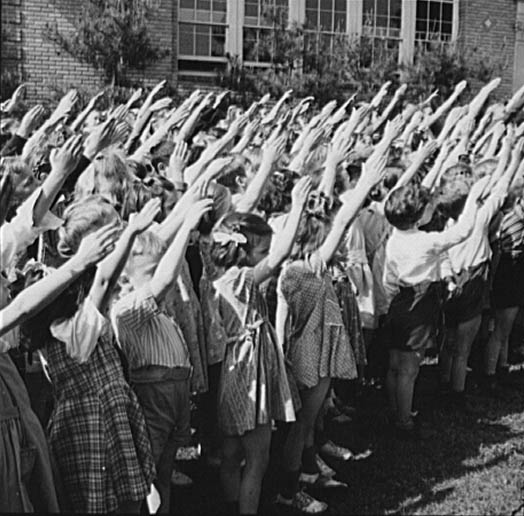Pledging Allegiance
Francis Bellamy died on August 28, 1931. His name has mostly been lost to history. Despite this, most Americans can recite by heart the current version of his greatest work — the Pledge of Allegiance.
He is also responsible for the Bellamy Salute, pictured below.

It isn’t what you think.
In 1892, Bellamy was employed by a magazine called The Youth’s Companion, which, as a premium for subscribing, sent American flags to purchasing schools. The giveaway was not just (or even primarily) a marketing ploy, though. It was in furtherance of the mission of the magazine, as its publisher wanted to “instill the idea of American nationalism” in the schoolchildren of the day, per Wikipedia. Bellamy was a fellow traveller in those efforts, hoping to rekindle American patriotism, as it had waned since the close of the Civil War a generation or two prior. He came up with the Pledge in support of that goal, and the magazine marketed it in conjunction with the 400th anniversary of Christopher Columbus’ arrival in the New World.
Bellamy and the publisher promoted the Pledge in the September 8, 1892 edition of the magazine. Bellamy went on a roadshow, meeting with superintendents to encourage them to install flags and adopt the Pledge. Published along with the Pledge was a salute, pictured above, which Bellamy took upon himself to demonstrate to these school administrators. The Bellamy Salute, as it would later be named, came with specific instructions:
At a signal from the Principal the pupils, in ordered ranks, hands to the side, face the Flag. Another signal is given; every pupil gives the flag the military salute — right hand lifted, palm downward, to a line with the forehead and close to it. Standing thus, all repeat together, slowly, “I pledge allegiance to my Flag and the Republic for which it stands; one Nation indivisible, with Liberty and Justice for all.” At the words, “to my Flag,” the right hand is extended gracefully, palm upward, toward the Flag, and remains in this gesture till the end of the affirmation; whereupon all hands immediately drop to the side.
Unfortunately the Bellamy Salute was very similar to the traditional Roman one, which Benito Mussolini and then Adolf Hitler adopted for their own supporters. By the early 1940s, the symbolism of such a salute was not longer one of allegiance to the American flag, but rather to Nazi Germany. On December 22, 1942, the United States Congress adopted the Flag Code, dropping the Bellamy Salute from the Pledge of Allegiance, and replacing it with the instruction that the speaker place his or her right hand over his or her heart.
Bonus Fact: You’ll note that the original pledge is a bit different than the current one. The Pledge underwent two significant changes in the years since Bellamy originally drafted it. In 1923 (with a small additional change in 1924), the National Flag Conference added the words “of the United States of America” after the words “to the Flag,” in order to make it clear to immigrants that the country they were pledging allegiance to was their new nation. In 1954, according to Discovery, the phrase “under God” was added “amid a red scare over the threat of the Soviet Union [and its state-mandated atheism].”
Double bonus!: August Landmesser joined the Nazi party in 1931, believing that it would help him find a job. But his allegiance to the party was minimal otherwise. He married a Jewish woman and was twice arrested for “dishonoring the race” and ultimately, imprisoned for the crime. He served in a penal battalion and was likely killed in battle toward the end of World War II. But that’s not his claim to fame. This picture is. At a June 13, 1936 rally, a single person was caught on camera refusing to perform the Nazi salute; it’s generally believed (although uncertain, and understandably so given the context) that the person was Landmesser.
From the Archives: The First American Flag Was Very British Looking: The title tells the fact, click for the story.
Related: “To the Flag: The Unlikely History of the Pledge of Allegiance” by Richard J. Ellis. 4.4 stars on 9 reviews.
